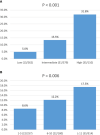Prognostic Factors of Small Non-Functional Pancreatic Neuroendocrine Tumors and the Risk of Lymph Node Metastasis: A Population-Level Study
- PMID: 35873006
- PMCID: PMC9299363
- DOI: 10.3389/fendo.2022.907415
Prognostic Factors of Small Non-Functional Pancreatic Neuroendocrine Tumors and the Risk of Lymph Node Metastasis: A Population-Level Study
Abstract
Background: Small non-functional neuroendocrine tumors (NF-PNETs) are a heterogeneous subset of tumors with controversy regarding their optimal management. We aimed to analyze the prognostic factors of patients with small NF-PNETs and create a risk score for lymph node metastasis (LNM).
Methods: Data of 751 patients with NF-PNETs ≤ 2 cm were obtained from the Surveillance, Epidemiology, and End Results (SEER) database. Multivariate survival analysis was performed to analyze the prognostic factors. Logistic regression was used to identify risk factors for LNM.
Results: Of the 751 patients, 99 (13.2%) were confirmed to have LNM. In multivariate survival analysis, LNM (hazard ratio [HR], 2.12; 95% CI, 1.04-4.32, p = 0.040) was independently associated with disease-specific survival. Logistic regression identified that tumor location in the head of the pancreas (odds ratio [OR], 4.33; 95% CI, 2.75-6.81; p < 0.001), size ≥ 1.5-2 cm (OR, 1.84; 95% CI, 1.17-2.87; p = 0.009), and grade III-IV (OR, 7.90; 95% CI, 1.79-34.90; p = 0.006) were independent risk factors of LNM. According to the OR value, the risk of LNM was scored as follows: a score of 1 for tumors located in the body/tail of the pancreas and 4 for those located in the head; a score of 1 for tumors <1 cm and 2 for those ≥1.5-2 cm; and a score of 1 for tumors with grade I-II and 8 for those with grade III-IV. Finally, the median score for this cohort was 4, with an interquartile range of 3-6. Therefore, patients were classified as three groups based on the risk score system: a total score of 1-3 for low risk, 4-6 for intermediate risk (OR, 2.98; 95% CI, 1.59-5.60; p = 0.001), and 7-14 for high risk (OR, 8.94; 95% CI, 4.50-17.7; p < 0.001), with an incidence of LNM 5.0%, 13.5%, and 31.8%, respectively (p < 0.001).
Conclusion: Surgical resection with regional lymphadenectomy is recommended for small NF-PNETs with malignant potential of LNM. A risk score for LNM based on tumor grade, location, and size may preoperatively predict LNM of small NF-PNETs and guide clinical practice.
Keywords: SEER; lymph node metastasis; non-functional; pancreatic neuroendocrine tumors; prognosis; small tumors.
Copyright © 2022 Tan, Wang, Li, Liu, Liu and Ke.
Conflict of interest statement
The authors declare that the research was conducted in the absence of any commercial or financial relationships that could be construed as a potential conflict of interest.
Figures



Similar articles
-
Value of lymphadenectomy in patients with surgically resected pancreatic neuroendocrine tumors.BMC Surg. 2022 May 10;22(1):160. doi: 10.1186/s12893-022-01595-y. BMC Surg. 2022. PMID: 35538535 Free PMC article.
-
Pancreatic neuroendocrine tumors: MR imaging features preoperatively predict lymph node metastasis.Abdom Radiol (NY). 2019 Mar;44(3):1000-1009. doi: 10.1007/s00261-018-1863-y. Abdom Radiol (NY). 2019. PMID: 30539251
-
Systematic Review and Metaanalysis of Lymph Node Metastases of Resected Pancreatic Neuroendocrine Tumors.Ann Surg Oncol. 2021 Mar;28(3):1614-1624. doi: 10.1245/s10434-020-08850-7. Epub 2020 Jul 27. Ann Surg Oncol. 2021. PMID: 32720049
-
Impact and Clinical Predictors of Lymph Node Metastases in Nonfunctional Pancreatic Neuroendocrine Tumors.Chin Med J (Engl). 2015 Dec 20;128(24):3335-44. doi: 10.4103/0366-6999.171427. Chin Med J (Engl). 2015. PMID: 26668149 Free PMC article.
-
Impact of Regional Metastasis on Survival for Patients with Nonfunctional Pancreatic Neuroendocrine Tumors: A Systematic Review.Ann Surg Oncol. 2024 Aug;31(8):4976-4985. doi: 10.1245/s10434-024-15249-1. Epub 2024 Apr 23. Ann Surg Oncol. 2024. PMID: 38652199
Cited by
-
Accuracy and Prognostic Impact of Nodal Status on Preoperative Imaging for Management of Pancreatic Neuroendocrine Tumors: A Multi-Institutional Study.Ann Surg Oncol. 2024 May;31(5):2882-2891. doi: 10.1245/s10434-023-14758-9. Epub 2023 Dec 14. Ann Surg Oncol. 2024. PMID: 38097878
-
Development and validation of CT-based radiomics deep learning signatures to predict lymph node metastasis in non-functional pancreatic neuroendocrine tumors: a multicohort study.EClinicalMedicine. 2023 Oct 24;65:102269. doi: 10.1016/j.eclinm.2023.102269. eCollection 2023 Nov. EClinicalMedicine. 2023. PMID: 38106556 Free PMC article.
-
Predictive and prognostic nomogram models for liver metastasis in colorectal neuroendocrine neoplasms: a large population study.Front Endocrinol (Lausanne). 2025 Jan 7;15:1488733. doi: 10.3389/fendo.2024.1488733. eCollection 2024. Front Endocrinol (Lausanne). 2025. PMID: 39839478 Free PMC article.
References
-
- Falconi M, Eriksson B, Kaltsas G, Bartsch DK, Capdevila J, Caplin M, et al. . ENETS Consensus Guidelines Update for the Management of Patients With Functional Pancreatic Neuroendocrine Tumors and Non-Functional Pancreatic Neuroendocrine Tumors. Neuroendocrinology (2016) 103:153–71. doi: 10.1159/000443171 - DOI - PMC - PubMed
Publication types
MeSH terms
Supplementary concepts
LinkOut - more resources
Full Text Sources
Medical

